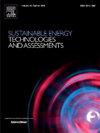Experimental optimization of the performance and energy distribution of a direct injection hydrogen engine with analysis of application to onboard hydrogen storage methods
IF 7.1
2区 工程技术
Q1 ENERGY & FUELS
Sustainable Energy Technologies and Assessments
Pub Date : 2024-10-21
DOI:10.1016/j.seta.2024.104034
引用次数: 0
Abstract
Hydrogen internal combustion engines (H2ICE) and proton exchange membrane fuel cells (PEMFC) have been proven to offer high thermal efficiency and sufficient power density for light-duty vehicles. Gaseous, high-pressure, compressed hydrogen is widely used for onboard hydrogen storage, but its low storage density and the high-security risk are a concern. Other hydrogen storage methods have advantages in safety or density but require high heated temperatures or large dehydrogenation energy which is difficult for PEMFC. However, higher exhaust temperatures of over 400℃ and energy from hot (∼100℃) coolant from H2ICE provide the potential for applying other hydrogen storage methods. In this paper, the performance of a 2.0 L turbocharged direct injection H2ICE was optimized by applying a variable geometry turbocharger (VGT) to gain better intake flow with a high power of 124.8 kW. Effects of five significant parameters of engine speeds, intake valve timing, VGT opening, injection timing, and intake pressure are explored using 1st and 2nd law energy balance analysis to gain the maximum BTE of 43.03 %. The potential of various hydrogen storage methods is evaluated by comparing onboard hydrogen producing temperature and required exergy against that available from the engine. The availability of applying new onboard hydrogen storage methods including all physical storage categories and some material storage methods has been demonstrated.
通过实验优化直喷式氢气发动机的性能和能量分布,并分析其在车载氢气储存方法中的应用
氢气内燃机(H2ICE)和质子交换膜燃料电池(PEMFC)已被证明可为轻型汽车提供较高的热效率和足够的功率密度。气态、高压、压缩氢被广泛用于车载氢存储,但其存储密度低和高安全风险令人担忧。其他储氢方法在安全性或密度方面具有优势,但需要较高的加热温度或较大的脱氢能量,这对 PEMFC 来说是很困难的。然而,400℃ 以上的较高排气温度和来自 H2ICE 的热(100℃)冷却液的能量为应用其他储氢方法提供了可能。本文通过应用可变几何涡轮增压器(VGT)优化了 2.0 L 涡轮增压直喷式 H2ICE 的性能,以获得更好的进气流,并获得 124.8 kW 的高功率。利用第一和第二定律能量平衡分析,探讨了发动机转速、进气门正时、VGT 开度、喷射正时和进气压力这五个重要参数的影响,以获得 43.03 % 的最大 BTE。通过比较车载氢气产生温度和所需放热量与发动机提供的温度和放热量,评估了各种氢气存储方法的潜力。新的车载氢气存储方法包括所有物理存储类别和一些材料存储方法,这些方法的可用性已得到证实。
本文章由计算机程序翻译,如有差异,请以英文原文为准。
求助全文
约1分钟内获得全文
求助全文
来源期刊

Sustainable Energy Technologies and Assessments
Energy-Renewable Energy, Sustainability and the Environment
CiteScore
12.70
自引率
12.50%
发文量
1091
期刊介绍:
Encouraging a transition to a sustainable energy future is imperative for our world. Technologies that enable this shift in various sectors like transportation, heating, and power systems are of utmost importance. Sustainable Energy Technologies and Assessments welcomes papers focusing on a range of aspects and levels of technological advancements in energy generation and utilization. The aim is to reduce the negative environmental impact associated with energy production and consumption, spanning from laboratory experiments to real-world applications in the commercial sector.
 求助内容:
求助内容: 应助结果提醒方式:
应助结果提醒方式:


